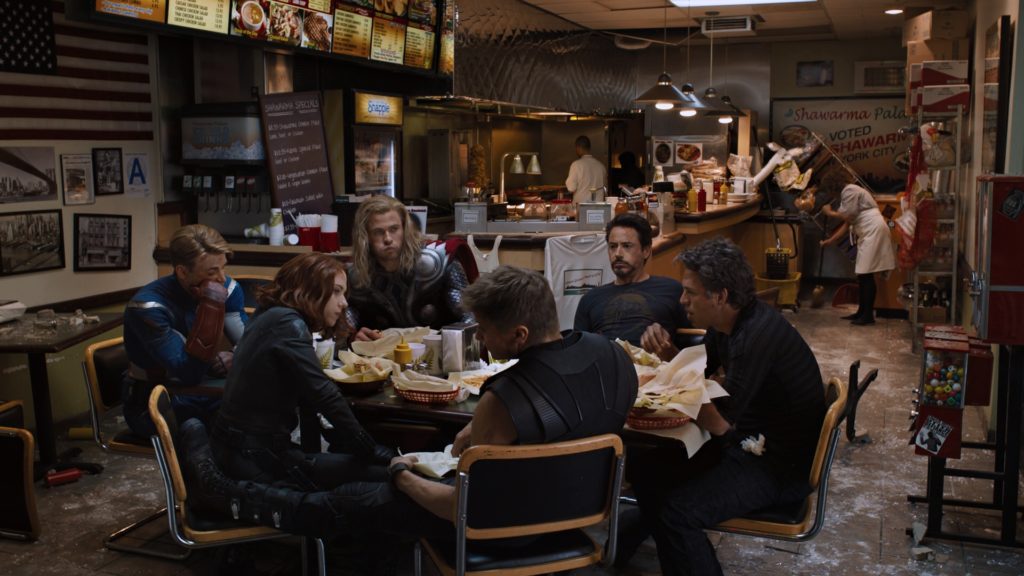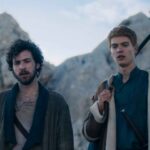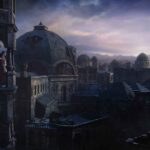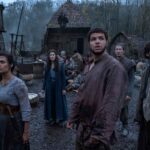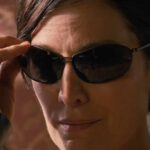In this weekly series, we chronicle the long road undertaken by the Marvel Cinematic Universe movies to arrive at Avengers: Infinity War. We introspect and discuss the movies from a critical and commercial standpoint while also considering the development efforts that went behind them. These articles may be occasionally sprinkled with spoilers so please make sure to skip the relevant sections when reading.
This post is about the 2012 movie The Avengers, the sixth chapter in the Marvel Cinematic Universe.
Back in 2008 when Marvel Studios announced The Avengers as a team-up crossover event signaling the culmination of the storylines of all its movies released until that point, it was widely regarded as a risky move. In an industry where sequels were decided on a movie-by-movie basis depending upon the success or failure of the current installment, Marvel was essentially committing to release a team-up film comprising of B-movie characters, most of which had yet to prove their mettle at the box-office. All Marvel had when it declared its intentions to produce this mega-event were its first two movies Iron Man and The Incredible Hulk, with only the former having managed to leave a lasting impression. The sheer audacity of the move meant that the industry’s geeks, nerds and comic enthusiasts were watching with prying eyes on how exactly would Marvel fulfill its promise. It also resulted in some disagreements internally within Marvel Studios leading to the departure of producer Avi Arad, who backed the widely acclaimed Sam Raimi Spider-Man movies.
Looking back at it after almost a decade though, The Avengers almost seems like a no-brainer. In fact, it’s become a poster-child of sorts for the kind of event-movie that everyone has been struggling to recreate. Such was its impact and success that even Marvel’s own sequel to that movie with a couple of additional heroes thrown in for good measure couldn’t match up to the original. Rivals are announcing a slate of releases years in advance leading to a crossover in hopes of matching up to the Marvel model of success, yet 5 years later none quite still has it figured out. The Avengers presented its viewers with a one of its kind experience at the time, uniting heroes who had headlined their own solo features in an ensemble and balancing some tragic dark moments with generous dozes of wit, humor and hearty banter. As far as crossovers go, it remains unbeatable to date.
In a way, its astounding success is baffling. After all, at the time there were several arguments against it. It was an era where actors were hesitant to commit to long term projects, fearing stagnancy from playing the same character over and over again. How would such actors be persuaded of signing long-term contracts for 5-6 movies in one shot? How would the schedules of these actors be coordinated to film this giant sandwich of a movie? Who would be a foe worthy enough to challenge a team of super powered individuals without appearing under powered himself? And most importantly, how would the differing tones established in different lead-up movies mesh together? How could the grounded world of Iron Man, the cosmic realms of Thor and the World War themed Captain America be brought together and made to work?
For a project like this, one of the key hiring choices Marvel could make was that of a director. And from all the names available to choose from, Marvel went with the relatively obscure Joss Whedon, primarily because of his ability in handling ensembles effectively in the limited directorial gigs he had scored until then. Whedon, who was largely known for his TV Shows Firefly and Buffy The Vampire Slayer was a big comic-book fan himself and his recruitment would turn out to be the best decision Marvel would make in bringing their team-up to the big screen. Discarding an earlier draft by writer Zak Penn and adhering to Marvel’s guidelines for mandatory plot points that should make their way in the movie, Whedon set out to write his own version of the script, one that would see the core team members exchange frequent quips that would play off handsomely on Marvel movies released in their cinematic universe up to that point.
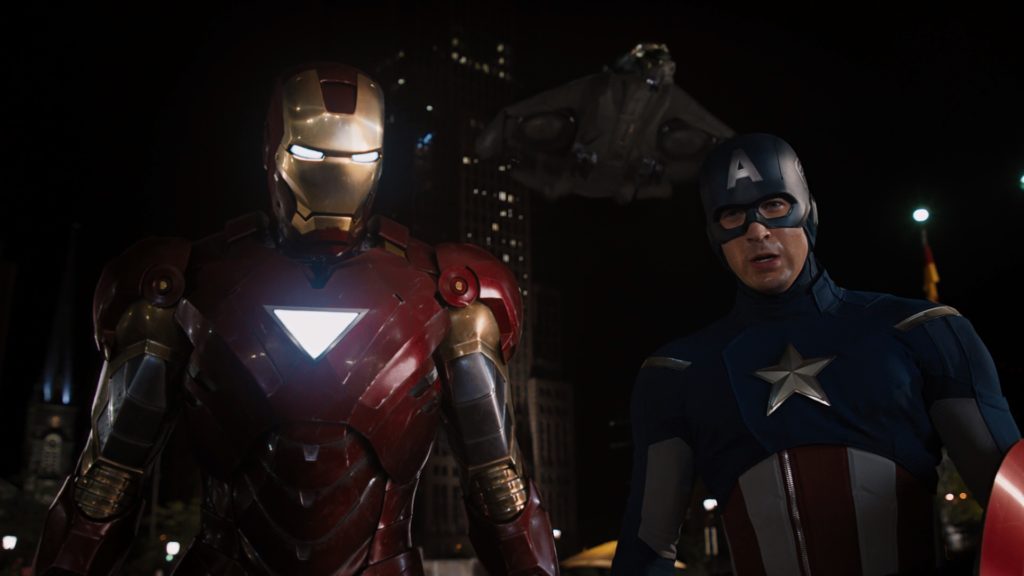
One of the cool things Whedon did was to take the central challenge of differing tones and build the movie around it, effectively working the movie’s most capricious element in its favor. Just as it would be hard for the different worlds inhabited by these characters to mesh together, so too would it be nay impossible for the characters themselves to get along. Using that as a starting point, Whedon’s script brilliantly bounced off the egos of all team members resulting in some of the finest dialogues written for the MCU, or even for superhero movies in general. It’s the kind of writing that turns an otherwise fairly predictable plot into a rather interesting examination of the psyches of these assorted individuals.
Speaking of which among the few gripes that people (myself included) have with this movie is the generic plot and the generic nature of the threat that brings the heroes together. Thor’s brother Loki is essentially hired by The Other, the leader of an alien race of reptilian creatures referred to as the Chitauri to fetch the Tesseract from Earth. Loki arrives on Earth, snatching the Tesseract from S.H.I.E.L.D. custody and works with his captives to harness its energy so that it can be used to open up a Portal to Earth, unleashing a massive Chitauri army to invade it. Having seen first hand the level of destruction the blue cube is capable of, Nick Fury, director of S.H.I.E.L.D. kicks off the Avengers Initiative and sends his agents to assemble Tony Stark, Steve Rogers and Bruce Banner together to team up to save the world. After initially disagreeing with each other, they finally learn to work as a team and drive the Chitauri away with their combined might.
There’s nothing in this entire outline that stands out when compared to many other superhero movies. It’s flat-out generic and a far cry from the ground-breaking stuff one expects from a movie milestone as this. I suppose it’s understandable for Marvel to try and minimize the risk quotient of this project in some aspect of it’s development. Given that its very existence is a gamble in itself, Marvel probably chose to play it safe by sticking to the standard heroes-save-New-York-from-destruction plot. The entire climax evokes shades and visuals of Transformers: Dark of the Moon, a fact that even Marvel Producer Kevin Feige wasn’t shy of acknowledging. Even so, it’s notable that they’re still paying homage to the earliest of the Avengers comics in the way and the nature of the threat that brings the team together; the first issue of Avengers had the titular team thwarting the attempts of Loki wanting to wreak destruction upon New York with his trickery. Marvel Studios under Feige was known for a diligent adherence to the comics and it showed even in the bravest of their ventures.
The Avengers is ground-breaking then, not for what its plot involves but how it advances its story. Whedon’s script is sharp at every turn and squeezes every chance it gets to throw in quick one-liners that are perfectly within the realm of its heroes’ characterizations. There are so many of them that it’d take a separate essay to list them down but one of the most effective ones is an exchange between Tony Stark and Steve Rogers aboard a ship carrying Loki to the Helicarrier. After Thor arrives and snatches Loki away, Stark and Rogers argue over how to tackle the situation. In keeping with his classic cautious and calculated mentality, Rogers suggests “We need a plan of attack.” Stark in his own quintessential witty and aggressively sharp-tongued way replies with “I have a plan. Attack.” It’s a short barb but you can instantly see that it’s sally, it’s smart and yet isn’t out of character for both Stark and Rogers. And like I said, there are just too many of these gems to count; the movie even delivers what’s in my opinion, the best use of “Hulk Smash”.
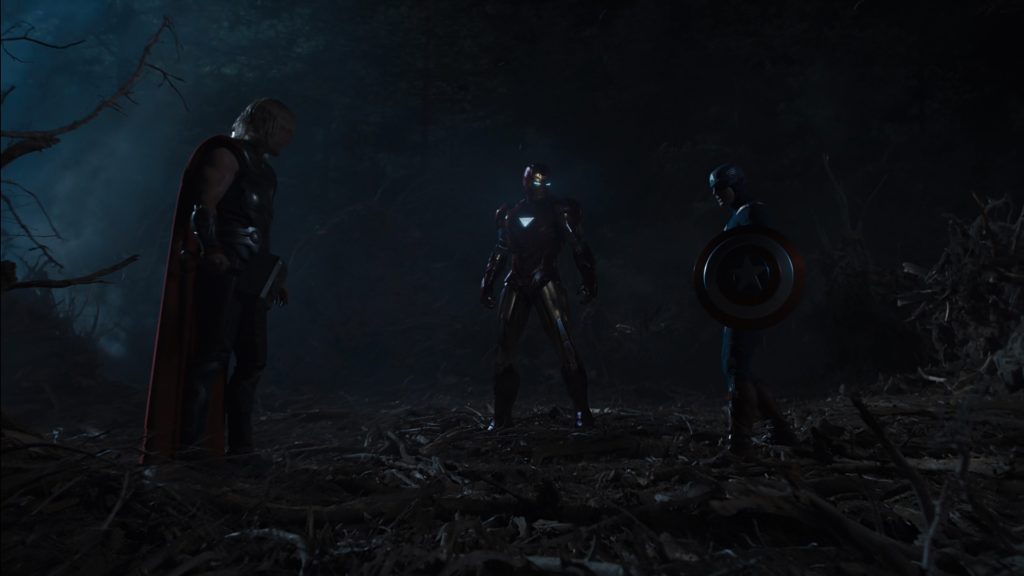
The aforementioned sequence leads into a fight between three of the Avengers in the forest, giving comic book nerds a wish fulfillment of sorts in which they not only see Thor square off with Iron Man and Captain America but also get answers to a few questions such as what would happen if Thor’s Hammer Mjolnir were to hit Captain America’s Vibranium Shield or if Thor threw a jolt of lightning at Iron Man’s armor. The square off is reminiscent of adult kids fighting and arguing over who gets the prized possession and it wouldn’t be wrong to state that the Avengers behave like children in a lot many instances. Another great moment born out of their childish need to disagree is in the argument that arises between the Avengers at the Helicarrier which also involves Nick Fury and Maria Hill. The six of them trade some sharp jibes tit for tat and the only complaint I have with this entire mesmerizing sequence is Stark’s delivery of the line “Genius, Billionaire, Playboy, Philanthropist”; the version in the trailer was much better and had much more attitude and flair. But these are small complaints in an otherwise brilliant scene that plays off plot threads from MCU films of each of the different heroes while unknowingly setting up future MCU installments.
There are three major action sequences in the movie, of increasing length. The first, as we discussed, was the fight between the trio of Avengers at the forest (excluding Banner). The second is an even more amazing scene set aboard the Helicarrier that follows the aftermath of the aforementioned spat the Avengers have. Two of the Helicarrier’s rotors are damaged resulting in it falling down and the Avengers need to work together to prevent it from reaching ground zero. Chaos abounds on the S.H.I.E.L.D. airbase and while Stark and Rogers work together to remedy the situation, Thor is busy containing a transformed Hulk from going on his rampage aboard the ship. It’s when viewing the outcome of this fight (which is a tragedy we’d avoid spoiling) that the Avengers really get something to fight for and it becomes the defining moment for the team to come together. The third and the most lengthy action set piece is actually the final alien invasion masquerading as a large-scale climactic battle that lasts well about half an hour. For any other movie, that would be borderline insane and enough for it to be declared a bore but Whedon ensures the action has enough heart and is accompanied with enough of the witty exchanges littered throughout the movie to make it interesting. That along with the payoff of seeing the team fight together means it plays out much more refreshingly and entertainingly than you can expect.
If one were asked to pinpoint the strongest aspect of The Avengers, the characters are what come to mind. Whedon’s script doesn’t necessarily take the characters to new places in terms of development but, to put it mildly, nails them and solidifies them in the minds of the audiences. And a large chunk of it has to do with the sharp dialogue peppered throughout the movie; even the so-called side-characters get their fair share of one-liners (ask Coulson and Sitwell). The cast seems to be having an equally great time and it reflects in their performances. Also, the fact that this paper thin plot is stretched out over two and a half hours means scenes play out in sufficient detail, everyone gets a lot to do and the ensemble is balanced effectively to ensure their strengths are highlighted and brought to the forefront.
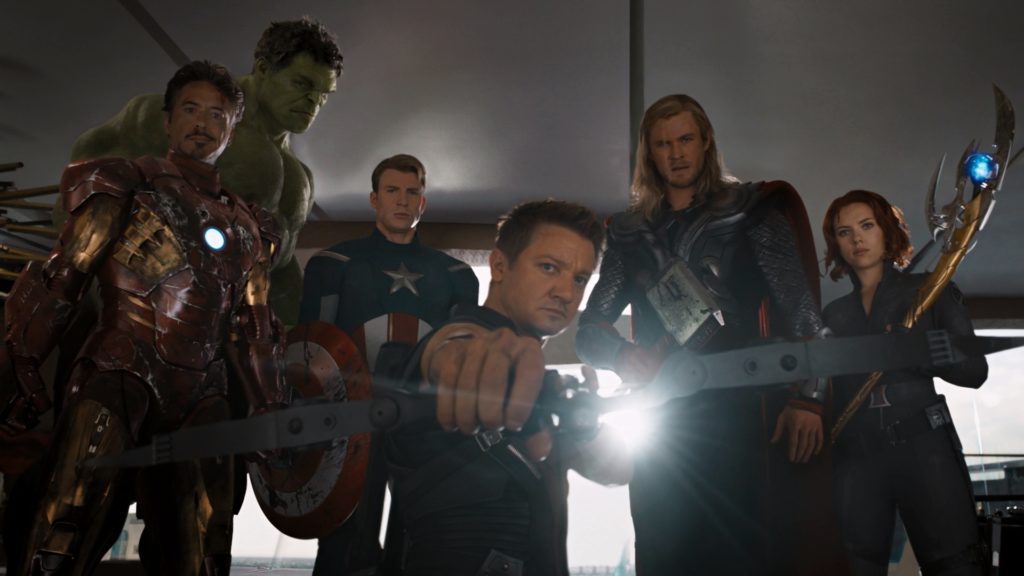
In keeping with his Television roots, Whedon chose to film The Avengers on a 1.85:1 aspect ratio, another unconventional move at the time. Big-budget films of this scale are most commonly shot on the 2.35:1 aspect ratio that fits well on a wide-screen frame as against the 1.85:1 aspect ratio which, while fits perfectly on IMAX screens, results in omnipresent black bars on the sides of the picture in most normal theaters. Cinematographer Seamus McGarvey explained it was to account for the height differences of the various characters from Black Widow to The Hulk and ensure they all fit comfortably in one frame for the more epic team shots. Whedon also keeps his Television aesthetic, refraining from excessively color grading the film in post-production. Despite the lengthy run time, the scenes all play out eloquently and editors Jeffrey Ford and Lisa Lassek ensure not a beat is lost in trimming footage down. Their editing is testament to the fact that only 5 minutes’ worth of deleted scenes exist in The Avengers and most are alternate openings and takes that probably wouldn’t have been as effective if left in.
Among the pantheon of accomplishments of the movie has to be its score by Alan Silvestri. Several memorable pieces of music are the outcome; some of the themes for the Helicarrier and the concluding sequences are equally melodious and grandiose. But perhaps the most important theme of them all is the theme for The Avengers which has a strong heroic touch to it that will make your hairs stand up in excitement. It’s one of the few bits of sound in the MCU that has survived all these years and has come to strongly represent the identity of the team. And since Silvestri also scored Captain America: The First Avenger, it only makes sense that he recycles bits of that theme to evoke Cap’s arc wherever appropriate and it lands with a solid impact.
The Avengers is one of the finest examples of dissonance among a band of members being used to create harmony. In Whedon’s own words, these superheroes “should not even be in the same room let alone in the same team”, which is what a family is all about. And yet they work because they have temperaments that contribute to a larger whole and personas that fit like pieces of a puzzle. Stark’s attitude if left unchecked can cause more problems than solve solutions. Thor would be clueless on what to do in a situation of this sort and The Hulk would be nothing but a raging monster laying waste to cities like Harlem. Black Widow and Hawkeye don’t stand a chance against these aliens but have plenty of stealthy insight into how S.H.I.E.L.D. operates. Cap’s leadership is the glue that brings everything together and Stark’s brains help the team survive the alien onslaught. It’s a classic case of one member of the team not being able to outweigh the threat on his own. And the skillful handling of these discordant individuals is what creates symphony instead of a cacophony.
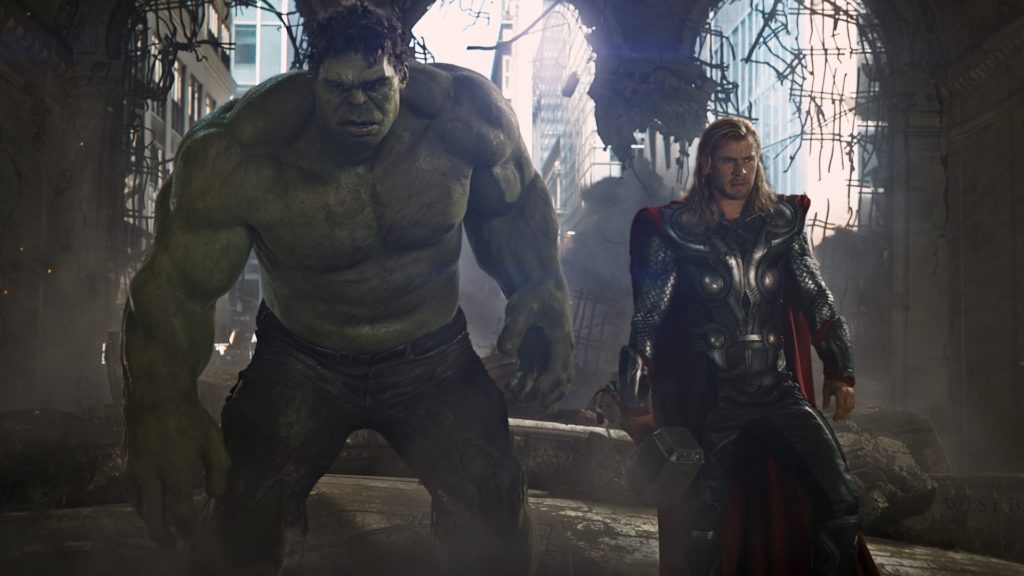 The Avengers was a box-office splash, going on to make much much more than its makers, the public, the critics or anyone else ever imagined. Ending up with a North American total of $623 million and a worldwide total of $1.6 billion, it shot right up to the third highest grossing movie of all time (currently fifth) and became the highest earning superhero movie ever, a record which even its own sequel couldn’t best. Critics enjoyed the movie but fans, nerds and comic geeks absolutely loved and adored the movie. It was for the comic con film folk, a new breed of filmmaking, one truly inspired by the comics and one that had the potential to continue delivering stories after stories for a long time. It was the start of a long era of intertwined movies that could continue for eternity.
The Avengers was a box-office splash, going on to make much much more than its makers, the public, the critics or anyone else ever imagined. Ending up with a North American total of $623 million and a worldwide total of $1.6 billion, it shot right up to the third highest grossing movie of all time (currently fifth) and became the highest earning superhero movie ever, a record which even its own sequel couldn’t best. Critics enjoyed the movie but fans, nerds and comic geeks absolutely loved and adored the movie. It was for the comic con film folk, a new breed of filmmaking, one truly inspired by the comics and one that had the potential to continue delivering stories after stories for a long time. It was the start of a long era of intertwined movies that could continue for eternity.
Marvel Studios was obviously not going to stop after such reception. There was no way this would be the end of this series of movies. And so, the movie’s end was marked as merely the end of a phase, with at least two more phases to follow. The next movie in the series then would begin a new phase of stories as the saga of the Marvel Cinematic Universe continued.
